
Climbing Shah Foladi, Afghanistan
Updated February 2023, Climbing Shah Foladi, Afghanistan was originally published in August 2021
Shah Foladi, Central Afghanistan’s highest peak rises to around 5,100 meters (I’ve seen it listed as anywhere from 5,048 meters to 5,192 meters), parked in the middle of the Koh e Baba Mountains that form the border between Bamyan and Wardak Provinces. Sure, Afghanistan has some taller peaks up in the Badakhshan Province, but ever since I stood there a few years back, looking up at a photo of the Shah Foladi area inside a guesthouse in Bamyan I knew I had to see it for myself.
Earlier this year I had to return to Afghanistan. Even at that point, I had a feeling that this may be the last time I go there for a long while, so I wanted to extend my time there to do something that has long been on my to-do list there, climb Shah Foladi.
This article has been sitting in my drafts 75% finished following our summit of Shah Foladi on the 24th of May, 2021 and unfortunately, I never found the time to publish this until now- so it’s worth mentioning that Afghanistan is currently in crisis, and the practical info in this post is essentially useless at this point in time.
Looking for more hiking in Bamyan? Check out my Bamyan trekking guide for more

Shah Foladi Summit, Bamyan Approach
Distance
24 kilometers
Elevation Gain/Loss
+ 1,798 meters
Time
3 days
Climbing Shah Foladi: Day 1
Distance
8.3 kilometers
Elevation Gain/Loss
+ 925 meters
Time
4 hours 30 minutes
We began our trek in the late morning to Shah Foladi from the village of Ali Beg, located right at the major fork of Foladi Valley, south of Bamyan town. The sun shined down on Ali Beg that morning, illuminating its beautifully terraced emerald crops framed by red soil, dotted with traditional mudbrick homes.

Weaving between fields of green following along shepherding trails, we made our way higher into Foladi Valley with the valley eventually becoming wider and the terrain more barren with those flashes of emerald giving way to dark rocks.
Following the course of the river flowing through Foladi Valley, the barren rock eventually gave way to a snow-covered valley floor as we gained altitude. Even in late May, the Koh e Baba still looked like they were tucked away into a winter season as we approached the 4,000 meter mark.

After 8 kilometers of leisurely walking, we arrived at the shores of a small and iced-over snowmelt-fed lake with views of Sarkh e Shah Foladi, a smaller yet prominent jagged peak- and perfect location to set up our Shah Foladi basecamp for the night.
Arriving in the late afternoon, we set up our tent and watched the sun creep down to the western horizon, disappearing behind the jagged Koh e Baba Range.

Plan your time in Bamyan Province: The Bamyan travel guide
Climbing Shah Foladi: Day 2
Distance
7.7 kilometers
Elevation gain/loss
+ 873 meters
Time
9 hours +
The second day, the day we would summit Shah Foladi, started early at 3:30 am. My guide planned for us to get an early start, wanting to begin the climb shortly after 4:00, but as this was only his second day dealing with me. He had no idea how great I can be at wasting time and staring off into space in the morning.
After eating our breakfast and sipping a concoction of dirty chai (where you dump your instant coffee flakes into a got glass of tea), we finally started to move at 6:00 am. As we climbed out of the tent to put on our boots the sun was up, but not over the Koh e Baba.

We trekked around the eastern shore of the lake we were camped the night previous before the valley rolled up a small knoll. A short distance beyond the knoll, we finally came into the morning light as we approached a spine of jagged peaks that we would ultimately weave behind to reach the summit later in the day.
Continuing toward the range, it became more apparent just how vertical this wall actually was. I did have some ice climbing experience under my belt, but nothing quite this tall.

My guide led and organized the first Afghan female expedition up Shah Foladi earlier in the year and told the story of the harrowing climb back down this vertical wall in the dark of night as the team took longer than anticipated to complete the summit. In fact, he had led several expeditions of foreign and Afghan climbers alike up to the summit of Shah Foladi and said on average the wall took about 3 hours for most climbers.

We clamped into crampons with ice axes in hand to begin our climb up the most difficult stretch of the journey to Shah Foladi. My guide had mentioned that they had installed a fixed rope near the exposed rock face on the west of the wall, but we couldn’t find it under the full season of snow blanketing the north face of the route.
Truth be told when we began the climb up it was a little nerve-wracking to think about climbing high above Foladi Valley, but once we got up a few meters and into the ascent, all those worries washed away.
In just 90 minutes’ time, we arrived at the top of the wall from a point where we had sweeping views to the north of Bamyan and to the south of Wardak Province. We opted to break here for lunch before continuing along the ridgeline to the west.


After lunch, we began our ascent up and down a dramatic ridgeline and toward the summit of Shah Foladi. The terrain varied from ice to snow to jagged rock on the way up and eventually, the summit came into view in the distance.
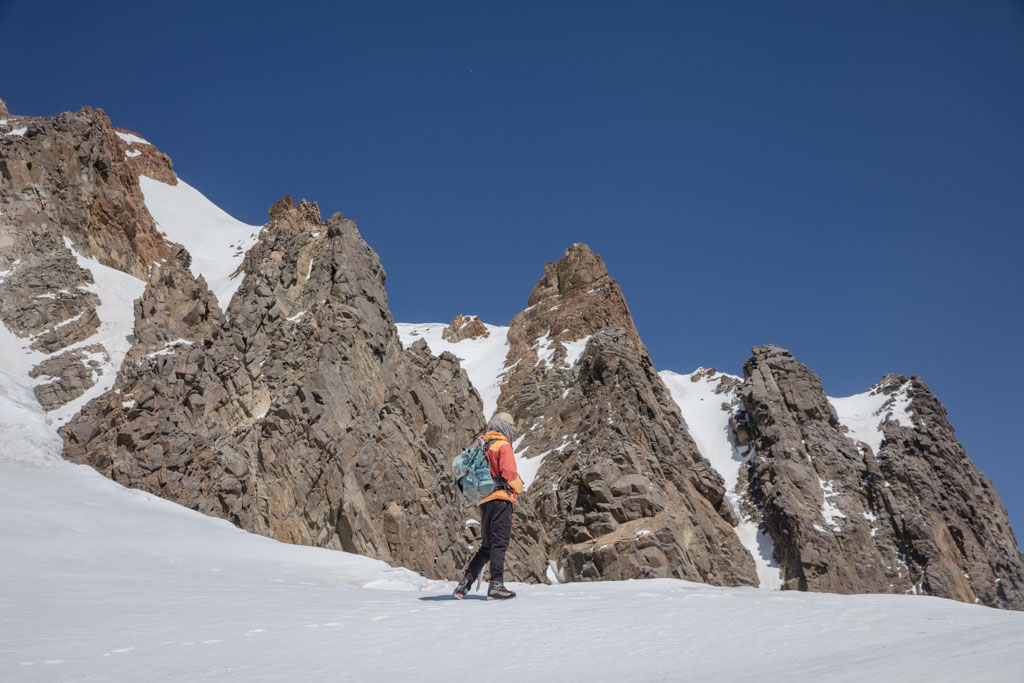

There were plenty of slips and slides on the final push to the top, but the last section was pretty straightforward, not really requiring any technical abilities.


After a short time celebrating and snapping photos from the top, we started our descent back to basecamp. The sun had warmed up the snow a noticeable amount, even in the short amount of time we spent at the summit. This somewhat expedited the going-down process as we slid down sections.

When we arrived back at the top of the wall, we broke again to eat candy bars and clip into our crampons yet again to make the vertical descent into Foladi Valley. Being that we were pretty tired from the ascent, I was a little nervous about going back down. But in all honesty, it ended up being my favorite part of the climb.
The final section down the wall we decided to treat like a giant sledding hill and slide down.
We finally arrived back to basecamp at around 3:30 pm as the sun began to dip behind the mountains.

The ultimate Afghanistan travel guide
Climbing Shah Foladi: Day 3
Distance
8.3 kilometers
Elevation gain/loss
– 925 meters
Time
2 hours 30 minutes
Day 3 was an easy one, essentially being the same as day 1, but in reverse. In about two and half hours’ we managed to arrive back in Ali Beg.
We walked into the village as school was letting out for the afternoon, so you can only imagine the crowd we attracted of curious onlookers giggling and laughing at us with our huge backpacks, high-fiving us and excitedly shouting ‘hello!’.

From Ali Beg we had a car arranged to drop us back off in Bamyan Town to get a night of rest before my next adventure began to other remote parts of Bamyan and Daykundi Provinces.
Note: For those that want to take on climbing Shah Foladi as a one-way trip rather than out and back, it’s possible to climb up the Bamyan side and down the Wardak side.
Don’t miss the beautiful Band e Amir National Park
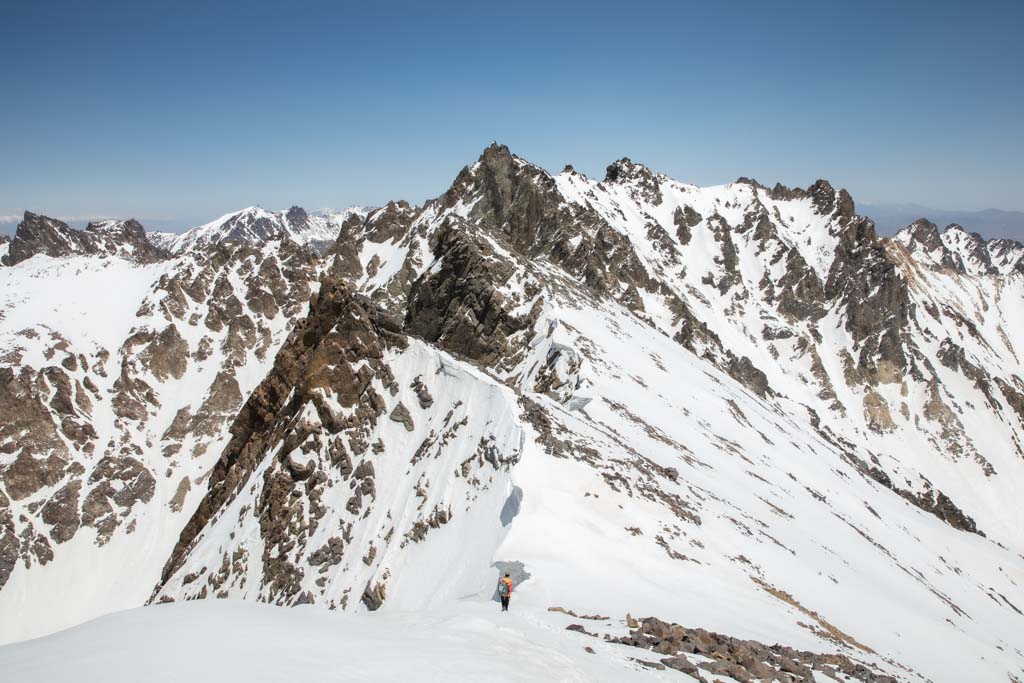
Shah Foladi Summit, Wardak Approach
Distance
32 kilometers
Elevation gain/loss
+ 2,807 meters/- 2,807 meters
Time
3 days
As I didn’t climb Shah Foladi from the Wardak approach, I will only provide general information that I have gathered from my guide who has led teams up this way as it is the easier approach of the two. The GPS file above is estimated from trail descriptions and satellite images. Climbing Shah Foladi from the Wardak side is longer and less elevation gain, though less technical.
The trek up Shah Foladi from the Wardak side begins from the village of Kamati, which is located in Foladi Valley, though further south down the western fork of the valley beyond Ali Beg. The trek will follow this arid valley to the south, albeit with some twists and turns.
Just slightly southwest of Shah Foladi Peak you will begin to follow a side valley that leads to the east. This valley will gain elevation, bringing you to a small turquoise lake, a great place to set up base camp.
The following day, you’ll make your ascent to the summit of Shah Foladi. Though this approach is still quite steep, it’s not as vertical as the wall on the Bamyan side, and not as technical- though crampons are definitely recommended for certain sections.
The Wardak approach will bring you to the top of the ridgeline, almost in nearly the same location as the top of the wall from the Bamyan side. From there, the final section of the climb to the summit is the same (see the previous section on climbing Shah Foladi from the Bamyan side).
After summiting you’ll return the exact same way you came. Plan to camp out at basecamp and then trek back to Kamati the following day.
Check out the cities of Kandahar, Mazar e Sharif, and Herat
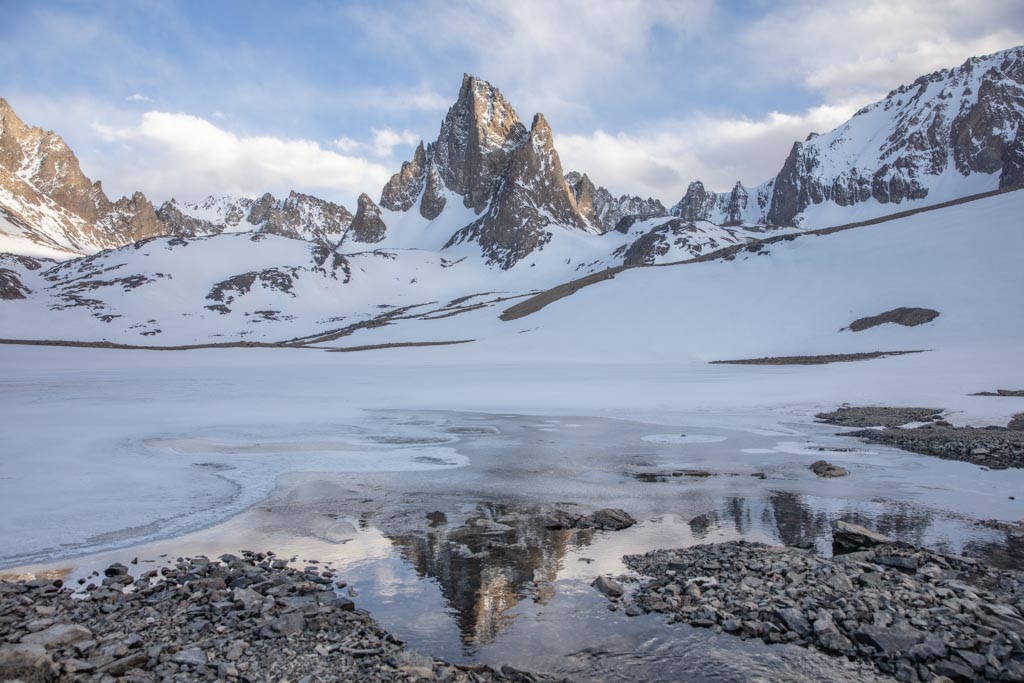
Shah Foladi Practical Information
Transport for the Shah Foladi Trek
Despite the fact that climbing Shah Foladi will not be a possibility for the foreseeable future, I still wanted to include the practicals.
As for getting to and from the start of either trek, you can plan for it to cost around 4,000 AFS to charter a vehicle from Bamyan Town (and back). Almost everyone does the climb up Shah Foladi with a local mountaineer, so they will make these arrangements for you. If you want help arranging this (someday) you can email me for contact info.
Read: Caught in an electric storm atop Koh e Mekh in Southern Bamyan
Shah Foladi Mountaineering Guides
It is best to hire a local mountain guide to take you up to the summit of Shah Foladi. For contact info, please email me. You can expect to pay a guide $70 USD per day for their services, this also includes tent, food, and gear portering by donkey).

What to Pack for Shah Foladi
- Hiking/mountaineering boots
- Gaiters
- Winter jacket
- Hiking/waterproof pants
- Gloves
- Warm trekking socks
- Sunglasses
- Crampons
- Ice axes
- Trekking poles
- Headlamp
- Inreach Explorer +
- Sleeping bag
- Sleeping mat
- Backpacking pack
- Day pack
The Best Time to Climb Shah Foladi
The best time to climb Shah Foladi, in general, is the spring months of March, April, May, and June.
For the Bamyan approach, the best time for the climb is before June. The vertical wall you must climb to reach the ridgeline typically melts out, exposing a large crevasse, making the route impassible- usually sometime in June.
It’s still best to climb the Wardak approach in the spring as well, though it does not have the same technical difficulties as the Bamyan side, so climbing later into the summer is actually possible this way.

Have any questions about climbing Shah Foladi?
Ask in the comments section below.
Need Travel Insurance?
Start shopping plans over at battleface.







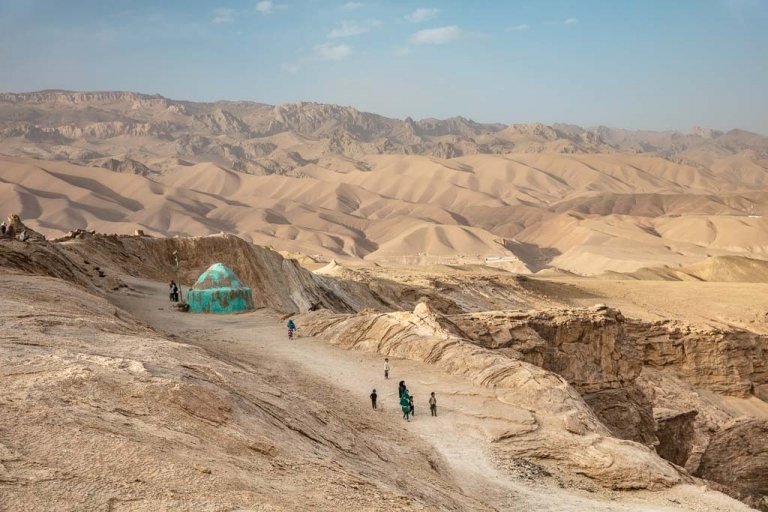
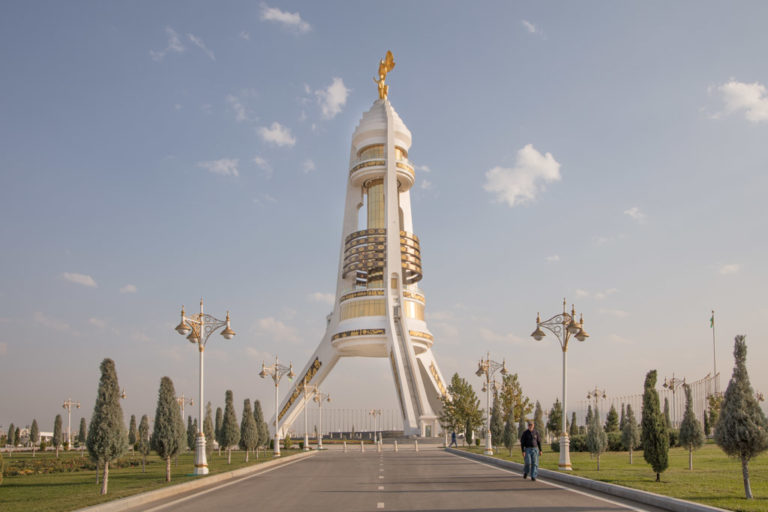



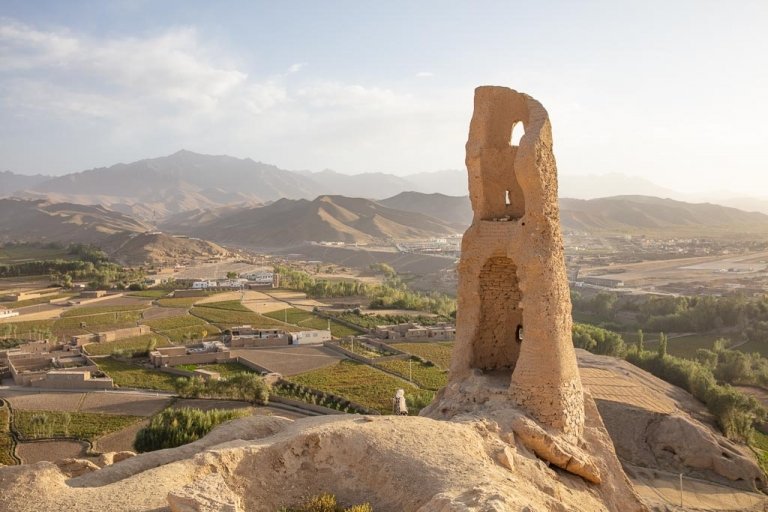







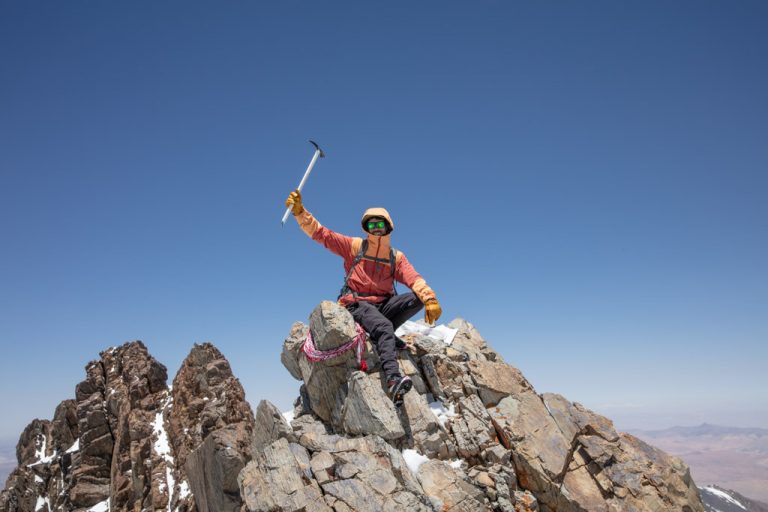













Wow! Quite the adventure! Many more places to see besides Afghanistan. Hope things clear up there soon but for now, stay away! Glad to see you posting more lately! Always fun stuff and different from most all the other blogs I see.